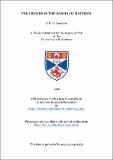Files in this item
The crowds in the Gospel of Matthew
Item metadata
| dc.contributor.advisor | Piper, Ronald A. | |
| dc.contributor.author | Cousland, J. R. C. | |
| dc.coverage.spatial | 236 p. | en_US |
| dc.date.accessioned | 2018-06-15T10:38:41Z | |
| dc.date.available | 2018-06-15T10:38:41Z | |
| dc.date.issued | 1992-07 | |
| dc.identifier.uri | https://hdl.handle.net/10023/14106 | |
| dc.description.abstract | Of the three major groups in Matthew's gospel, the disciples, the Jewish leaders and the crowds, it is the last of these, the crowds, which is most ambiguous. While the disposition of the disciples and the Jewish leaders toward Jesus is readily apparent, it is less so with the crowds. They have been characterized as ambivalent in their relationship to Jesus, and this ambivalence is borne out by the fact that some scholars have readily interpreted them in a negative light, others in a more positive light. As neither of these interpretations is especially compelling, the problem of the crowds has reached a critical impasse. It is the intention of this work to resolve this impasse, and explain the ambiguities of Matthew's portrayal, by offering a full-fledged examination of Matthew's understanding of the ὄχλοι. It begins by analyzing Matthew's use of the word ὄχλος, and determines that this word alone is used to refer to the crowds, and denotes a specific group. Matthew does rely on his sources for his portrayal of the crowds, but he has both clarified and stylized the portrayal. When Matthew's contradictory mission directives are analyzed, it emerges that the crowds are Jewish. After defining the crowds, it goes on to examine the crowds' actions and statements. It begins with a discussion of the crowds following of Jesus, and determines that the crowds follow Jesus not out of a "qualitative allegiance", but because they are needy. The crowds' astonishment in the face of Jesus' words and deeds does not indicate commitment on their part, but rather an incipient favourable response to Jesus. Their use of the title "Son of David" indicates a growing insight into Jesus' true nature, but one that ultimately fails to develop. Their designation of Jesus as "a prophet" indicates the inadequacy of their perceptions. It also adumbrates their final rejection of Jesus, a rejection which culminates in their joining with their leaders to accept responsibility for Jesus' death. The reproaches levelled against the crowds by Jesus in chapter 13 do not readily fit in with this portrayal of the crowds of Jesus' day, and are best seen as referring to the experience of Matthew's church. When the crowds are examined in the timeframe of Matthew's church, they are best regarded as Jews, and not members of Matthew's church. They are attracted to the church because of its authority to heal and forgive sins. They attach themselves to the community in large numbers, listen to the church's kerygma, but ultimately fall away when the church loses its thaumaturgic ability. Persecution by the Jewish leaders, particularly the Pharisees, may have provoked this crisis. After this, the crowds no longer heed the community's message, and appear to fall back under the sway of the Pharisees. Matthew's church reproaches the crowd for its obduracy, and embarks on its mission to all nations. The ambiguity in Matthew's depiction of the crowds is the result of two factors. In his portrayal of the crowds of Jesus' day, the ὄχλοι are used with two contradictory intentions in mind. On the one hand, they are used christologically to enhance the picture of Jesus, and to represent the side of Israel which welcomes its messiah. On the other hand, they are used apologetically, to show how Israel missed its messiah and ended up putting him to death. The second reason for the ambiguity of Matthew's account, is that the crowds sometimes, particularly in Matthew 13, represent the crowds of Matthew's day. This juxtaposition of the two temporal levels produces a refracted picture of the crowds, which also makes them appear ambiguous. | en_US |
| dc.language.iso | en | en_US |
| dc.publisher | University of St Andrews | |
| dc.subject.lcc | BS2576.C7 | en |
| dc.subject.lcsh | Bible. Matthew--Criticism, interpretation, etc | en |
| dc.title | The crowds in the Gospel of Matthew | en_US |
| dc.type | Thesis | en_US |
| dc.contributor.sponsor | Committee of Vice-Chancellors and Principals of the Universities of the United Kingdom | en_US |
| dc.contributor.sponsor | University of St Andrews | en_US |
| dc.type.qualificationlevel | Doctoral | en_US |
| dc.type.qualificationname | PhD Doctor of Philosophy | en_US |
| dc.publisher.institution | The University of St Andrews | en_US |
This item appears in the following Collection(s)
Items in the St Andrews Research Repository are protected by copyright, with all rights reserved, unless otherwise indicated.

